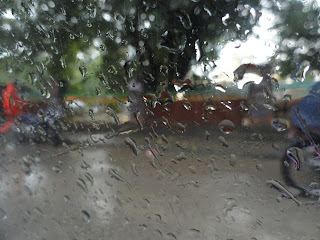You can be sitting in a café or waiting for a taxi and suddenly you’ll notice that the sky is a little darker than it was before. In the time it takes you to think that simple sentence, it will be raining cats and dogs… no rhinos and elephants. I was only in Cameroon for a few serious rainstorms, but the response here is the same as it was there: find the nearest doorway and wait it out. And to be honest, it’s really freeing. It’s nice not to have to rush through pummeling raindrops and leap over puddles because you have a 2:00 meeting and you can’t be late. It’s nice to stop and savor an extra 30 minutes to sit and read. It wouldn’t surprise me if a shopkeeper brought out tea if I ever found myself barricaded by a wall of water inside a little store.
In any case, here’s a little sampling of the monsoon. Just
keep in mind that these pictures only represent times when I could take out my
camera…so the heaviest rains aren’t represented.
Do you see the wake that motorcycle is leaving?
If you are unfamiliar with Nepal’s geography, the northern
border is formed by the Himalayas. Having the world’s most majestic mountain
range comes with certain risks, like a large magnitude earthquake roughly every
70-80 years.
You don’t have to be in Kathmandu very long to learn that
geologically, a significant earthquake is overdue. But there’s no way to
predict whether it will happen tonight, tomorrow, or two generations from now.
It’s the kind of uncertainty that can paralyze you if you let it; especially if
you take a minute to think about the compromised structural integrity of most
of Kathmandu thanks to the well-intentioned, but poorly executed, road widening
project. (Basically, the front three feet of buildings were shaved off to make
more space for traffic, which really means that the whole city is a
construction zone.)
Rather than packing my bags, I choose to take reasonable
precautions without letting fear cripple my experience. The U.S. Embassy in
Kathmandu has a long doom-and-gloom speech because it’s their job to prepare
for the worst case scenario, but I don’t want to live in a state of constant
anxiety.
Fortunately, the Fulbright commission in Nepal has done much
preparation for me. Let me introduce the “Go Bag.” According to the Embassy,
everyone should have at least one go bag containing the supplies necessary to
survive an earthquake and several days/weeks following. Ideally it will include
food, water, materials for building a shelter and keeping warm, a light source,
first aid kit, and a crow bar.
The commission was kind enough to provide each of the Fulbright
grantees with a fully-equipped “go bag” including the above and more. But when
you add up five kilograms of food, a tarp, an axe, blankets, and other supplies
you don’t get a go bag…you get a go barrel.
Some important considerations for making the most of a Go Barrel:
- Keep it outside. Mostly to attract the attention of all the neighbors, but also just in case the house crumbles during the quake. It would be pretty depressing to know that you have everything you need to survive, but it’s buried beneath a large pile of rubble.
- Keep it locked. You wouldn’t want your emergency supplies to be stolen.
- Since it’s locked, think carefully about where you keep the key since it would also be really unfortunate to get to your go bag safely outside with all the supplies intact and not be able to open the barrel of life.
When the earthquake happens, it will undoubtedly devastate
this city and country that I have come to love. People’s lives will shatter.
It’s the kind of destruction that I cannot even fathom. Please do not misinterpret this post as making light
of a genuine risk. But to cope with the uncertainty, I choose to laugh at
myself, and my big blue barrel.





Having always been one to dash right past a caution sign, I read on with eager anticipation into the "parents do not read section". My darling, life always has unexpected events. All we can do is live with the hope and assurance that when things happen the Lord will supply the strength and courage to forge ahead. I thank the Fulbright office for their thoughtful gift of a go barrel. Know also that before the go barrel, you were wrapped in a prayer blanket of safety and tucked under the wing of the almighty. So go, drink in every moment, have more fun that you ever imagined and enjoy this adventure....God and I have got your back!
ReplyDeleteLove ya,
Mom
I laughed about the "insulated from the weather" comment as you, like your mother, seem to have a pretty narrow temperature "comfort zone"--at least based on the complaining that I hear about the setting of the thermostat!
ReplyDeletePraying that your "go barrel" stays locked and unused, but grateful that there are folks in Nepal thinking about such things! Do the locals give this any thought?
Lv ya
Dad